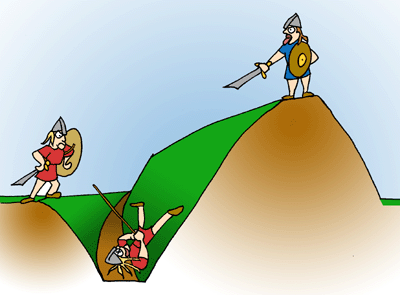|

|
|

Bloody Battles at
the Big Ditches in East Anglia
 The
Devil's Dyke is one of the largest ditches in Great Britain. It is
12km long and 4m deep. It also
has a 6m high bank (a wall made of earth). The
Devil's Dyke is one of the largest ditches in Great Britain. It is
12km long and 4m deep. It also
has a 6m high bank (a wall made of earth).- It is in Cambridgeshire.
- It would have taken 200 men about
three years to build it!
- There are (or were) other big
ditches nearby called Black Ditches, Fleam Dyke, Brent Ditch
& Bran Ditch.
- For over a century,
archaeologists have puzzled over when they were dug.
- Roman coins found beneath one
show that it was built after they
left Britain. Special techniques
have dated objects found in others to the 5th or 6th century.
This was during the Dark Ages.
- The Saxon Kings of East
Anglia had only just set up their kingdom. The ditches
were probably built to keep out the British from Calchfynedd.
- They showed where the border
was.
- They protected an important
road called the Icknield Way.
- Soldiers posted there could
control people going in and out. If they were traders
(people selling things),
they could make them pay taxes.
- They could be used to defend
the kingdom during a war.
- The banks & ditches may have
been improved in the 7th century. Calchfynedd had been taken
over by another Saxon group called the Mercians.
Their king, Penda, wanted to
rule over East Anglia too. There were lots of bloody battles.
The ditches were no match for his mighty army which killed
many East Anglian soldiers and 3 Kings.
- In the 10th century, England
became one country. There was lots of arguing about who should
be king. Some of King Edward the Elder's relatives wanted to
rule instead of him. Edward hunted down one cousin to East
Anglia, but he and his friends hid behind the dykes.
- The Devil's Dyke was then just
known as the 'Great Dyke' or 'St. Edmund's Dyke'. It was in
Medieval times that people called it the 'Devil's Dyke'. They
thought it had been made by his fiery tail as he was chased
away from a wedding at nearby Reach Church!
- There is a similar big ditch in
the South-West called Wansdyke.
|
|

